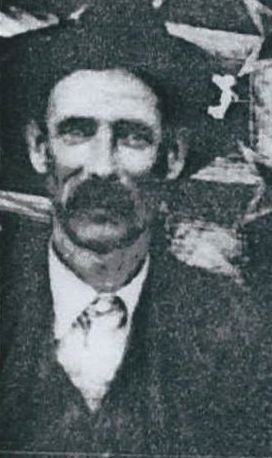There was not much of a fight it seems until Doc’s rifle entered the trial. What happened that almost caused a mistrial? Why would Doctor Taylor’s legal fight be dismissed in the higher courts?
Civil War in the Mountains
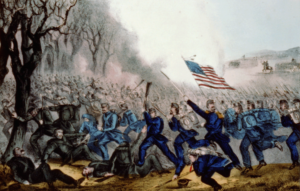
The Civil War affected the Appalachian people of West Virginia, Kentucky, and Southwestern Virginia like no other people. In the mountains, family feuds were not uncommon before the war, but here the Civil War adage of brother verses brother and family verses family really occurred.
Although the Civil War would end in May of 1865, for the people of these mountains the strife and struggle of the war would continue for years. These un-Civil Wars known as family feuds would become more bitter and bloodier than ever before.
There were dozens if not hundreds of feuds, for the most part these feuds were between different families. But after the Civil War some of the most bitter and the bloodiest feuds often happened among members of the same family.
The Hatfield and McCoy Feud

The most famous of the feuds was of course the one between the Hatfield’s and the McCoy’s. The feud drew national attention. And as the feud was winding down, the reporters sent to cover it started to report on other events happening in the area.
Some of these reporters often tried to tie these events to the Hatfield and McCoy feud in some way. If unable to do so, the events were often portrayed as previously unreported feud activity between the families of the people involved in them.
Even though these feuds may or may not have existed, we find ourselves grateful to those reporters. As this is the only reason that we can find national reports about certain events and people like Henry Vanover, Ira Mullins, Talt Hall, and Clifton Branham prior to the end of the Hatfield and McCoy feud.
Consolidation Coal Company
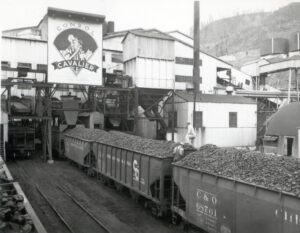
As the famous feud was ending, national interest in the area waned. Newspaper reporters began to withdraw from the area and then The Pound Gap Massacre occurred.
The timing of these two events, and their proximity to each other would continue to generate newspaper headlines about the people involved in them, and the area well into the 1900s.
When the area would once again make national headlines about the Consolidation Coal Company and the 7 modern cities they were building. Combined these 3 events continued to make national headlines well into the 1940s.
But unlike Consol and the Hatfield and McCoy feud, only the Pound Gap Massacre generated dozens of new and contradicting myths, stories, and folk tales. We believe that the reason this occurred can be tied directly to the trial of Dr. Marshall Benton Taylor, the actions of Commonwealth Attorney Robert Bruce, and… The unreliable testimony of Jane Mullins.
Doctor Taylor’s Rifle Myth
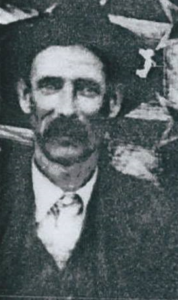
But an even greater reason for the rise of these myths, stories, and folk tales can be attributed to the Rifle of Doctor Taylor and the 4 affidavits about it that is attached to the transcript of the trial.
And these myths, stories, and folk tales occurred before the contents of the transcript and the affidavits of the trial were known to the general public. In fact, there is no evidence that the public had any knowledge of them until Charles Johnson wrote his 1938 book “A Narrative History of Wise County Virginia”.
But there is evidence that the public may have had a general knowledge of the particulars of the case. Even though the exact contents of the transcript and the affidavits were unknown.
Normally this would be attributed to newspaper reporting. But in the case of the Taylor trial, the local newspaper had been shut down from April 1892 through December of that year. In addition, no national newspaper reported anything other than the verdict of the trial. So, the source of the public knowledge of their contents remains a mystery.
Was the Jury’s Decision a Just One?
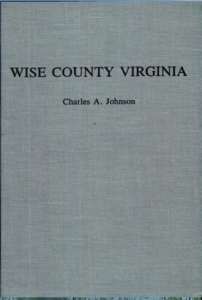
In his book, Mr. Johnson tells us that after the verdict was returned against him, Dr. Taylor moved the court in arrest of judgment and to set aside the verdict of the jury and grant him a new trial for various grounds of error assigned at bar. Specifically, what was known to the public about this error can be found in a newspaper interview of Dr Taylor.
The interview was done while Taylor awaited appeal in the Lynchburg Va jail. And up until 1938, this was the only source of information that tells us that the jury examined and modified the rifle of Dr Taylor.
It is the affidavits which corroborate that newspaper story. They tell us that although the jury was granted permission to examine the rifle. No permission was given for them to disassemble the rifle, or to modify it. What’s more, we learn from the jailhouse interview that the examination and alteration was done without the knowledge or consent of the defense.
The court over-ruled the defenses move to arrest judgement based on the actions of the jury and refused to grant a mistrial on those same grounds. We are then told by Mr. Johnson that through his counsel, Dr Taylor “Excepted”. The defense then wrote out 12 bills of EXCEPTION. The court then signed these 12 bills and ordered them to be made a part of the court record of the case.
As we have said before, Mr. Johnson admits that he is not an historian. What’s more is that in telling the story of the Killing Rock Mr. Johnson is hard to follow because he is not linear in his record AND he tends to jump from topic to topic.
But if you take notes paying attention to what he says AND what he doesn’t say about a particular topic. You discover that Mr. Johnson was not happy that either certain parts of the court record had been lost OR that he was not allowed access to certain information.
These 12 EXCEPTIONS are a prime example.
Twelve Bills of Exception
Exceptions are no longer used in modern court cases. The reason for this is that an exception could possibly make a modern court transcript exceptionally long. What an exception was is a lengthy written out objection to a particular testimony, court ruling, or piece of evidence. These were meant to give a higher court insight into something that had occurred in a court case and provide justification for hearing an appeal.
Mr. Johnson was told about these 12 exceptions. He was told that the court or the Judge had signed them and ordered that they be made part of the Court Record. Yet he is also told that no record of what they were existed when he was doing his research.
Charles A Johnson
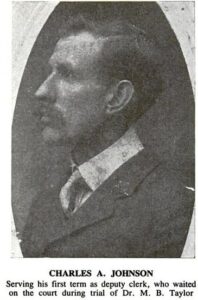
Charles A Johnson was a retired court clerk, and he was nearly blind when he wrote his book. He tells us that in some cases he had to have someone read some of the source material to him. We’re also told that his vision was so bad that he had to dictate the book and someone else had to type it out.
But by what he says about everything he was told about the Pound Gap Massacre. Mr. Johnson understood when someone was trying to pull the wool over his eyes. We also believe that is why he opens the section in his book about the trial by asking the same questions that have been asked about that trial for the past 130 years.
In “A Narrative History of Wise County Virginia” we are told that the transcript in the book was the only one in existence. And that this transcript was the one sent to the appellate court. We are then told that it is given to us word for word in the book. Does this mean that the 12 exceptions never made it to the appellate court?
Appeals
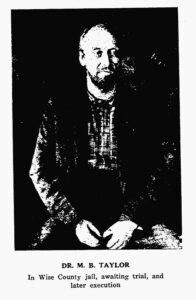
In addition to the information about the appeal in Mr. Johnson’s book, there are 2 newspaper clips that seems to bear this out. The first of these is dated Dec 1892 and tells us that the court was not going to hear the appeal, but one of the five appellate judges sent a last-minute stay of execution and that a court date would be set later.
The second article is from July 1893 and tells us of 3 cases the appellate court had heard that day. In two of these cases, we are given the majority and minority opinion of the case. We are also given the names and verdict vote of all 5 judges.
But in the Taylor case we are only given two of the judge’s names. In addition, we are told these two judges were in opposition without the opinion of either and one of them was the judge who had issued the last minute stay the previous December.
The often-told tale tells us that the appellate court ruled against Doctor Taylor BECAUSE no evidence was given that would have merited a new trial.
Case for a Mistrial
So, what happened in September 1892 that caused Doctor Taylor’s defense team to ask for a mistrial? After the move to declare a mistrial was over-ruled, what was the original EXCEPTION?
As we have already stated, Doctor Marshal Benton Taylor’s rifle is of the utmost importance, as the often-told tale states that the jury based its decision of guilt solely upon its findings when they, the jury, examined the rifle. This statement from the story is never given with any explanation. In addition, if this statement is true, then the testimony of Jane Mullins had been discarded by the jury.
While awaiting appeal in the Lynchburg jail an interview of Doctor Marshall Benton Taylor ran in the newspapers. The interview covered nearly a full page; however, the entire interview was not picked up by all outlets. What is often left out is the fact that Dr. Taylor and his defense team expected the appellate court to overturn the lower court’s decision. This belief was based upon the way in which the examination of his rifle took place by the jury.
Four Affidavits
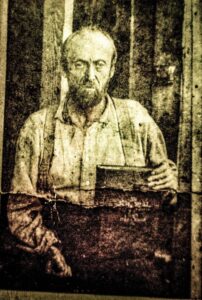
But what is not told in either the often-told tale or the newspaper interview is of the existence of the four affidavits. These affidavits are about the examination of Dr. Taylor’s rifle.
What’s more, is that they corroborate the statements made by Doctor Taylor in that interview. According to all four of the affidavits attached to the transcript of the trial, three of the jurors not only examined the rifle but they altered it.
When we examine the transcript of the trial, very little about the rifle is ever attested to. The prosecution focuses on the shell casings found at the crime scene and asking witnesses if they knew the make and caliper of Dr Taylor’s rifle. At first this seems strange until the defense calls their witnesses.
It is only during the testimony of the witnesses for the defense that the whereabouts of the rifle is discovered. In fact, when the original indictment was issued it read that Taylor had used “a gun valued at $5” to kill Ira Mullins.
When that indictment was quashed, the new indictment read “a pistol valued at $5”. But by the time of the September trial, the prosecution knew that Dr Taylor’s pistols did not match the ammunition found at the crime scene and shifted its focus to the lost rifle.
Focus of the Trial Changes
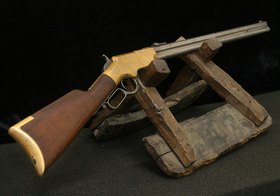
So why did the prosecution shift its focus to the rifle?
There are multiple clues as to why this happened.
The often-told story tells us that at the inquest, Henry Adams and James Potter were named as suspects because of the types of rifles they owned. However, the clue is found in the fact that these stories say that the casings were rim fire and were for a government issued rifle.
This is corroborated in another part of the story that may have directly come from the three jurors in the 1st affidavit. The often-told story says that Doc’s gun was “dry fired” using one of the shell casings found at the crime scene.
This story relates that the plunger or firing pin struck the shell casing “just off center” and did not match the original strike to the casing. This story is often given as the reason or excuse for the “examination” of the rifle by the jury. But it is the second affidavit that verifies the story of the shell casings being “rim fire”.
The affidavit was sworn out by I. N. Mills, this affidavit reads very much like the first affidavit. I think it is important to note here, that it is this similarity as well as others found in the transcript. Along with a few statements found in the transcript that are difficult to read or seem to make no sense.
That make us believe that some of the statements may have been altered. Especially when it comes to the statements about the ammunition casings found at the crime scene. And certain statements made about the rifle given as evidence BEFORE the rifle was found and was entered into evidence.
The part of Mr. Mills affidavit that is different from the 1st affidavit, and corroborates that the casings were rim fire, as well as contradicting several statements from the transcript reads “…upon such examination we reached the conclusion that the gun had been tampered with recently, so as to make the plunger strike the cartridge in the center instead of on the side, which examination caused me and F. P. Graham, to my knowledge, to find a verdict of guilty, while if we had not made such an investigation, we would not have found such a verdict, at least I know I would not, and Graham said he would not, but I do not know what effect it had on the other jurors.”
The 1st affidavit just tells us the names of the three jurors that disassembled and altered the rifle. We only know that the rifle was altered thanks to the final 2 affidavits made by Sheriff Holbrook and his gunsmith deputy. They tell us about a part of the rifle that the jury either could not or did not use when they reassembled it.
They also tell us that the deputy had examined the rifle before and after the jury examined it and when it was returned from the jury the firing pin was assembled in a way in which he had never seen before. This is probably where the story comes from which states that the rifle was now inoperable.
But the often-told story about the ammunition being rim fire is also corroborated by the affidavit of I. N. Mills. This means that all the testimony statements about the ammunition being 45×75 may have been altered. As well as the testimony about the number of rifles in the area as being 45×75. We base this upon the fact that both the story and the affidavit tell us that the Ammunition casings found at the scene were rim fired, and no true 45 caliber rim fired ammunition has ever been made.
This seems to play out in testimony about the rifle of Henry Adams. Twice it is given as being 45×75 but once it is stated that his rifle was 44×75… a rifle that did not exist in 1892. But a rim fired 44×70 repeating rifle did. and because of a low cost and very popular type of ammunition it was capable of using… Had the reputation of being government issued.
Thank You
We at Kentucky Tennessee Living would like to thank you for watching our series on The Killing Rock. Don’t forget to hit that like button as the more likes we receive the more likely YouTube is to suggest our videos to other viewers. Also, to receive notice when we upload a new video be sure to subscribe and click the bell notification.
We thank you for continuing to support Kentucky Tennessee Living. As we bring to you the history of the Appalachian Mountains. We must remind everyone that the story names Killing Rock: The Oft Told Tale (s) and Killing Rock: The Untold Story and Killing Rock: the Trial are all under Kentucky Tennessee Living copyright.
Source Information
A Narrative History of Wise County, Virginia By Charles A. Johnson Pub. 1938. The Trail of the Lonesome Pine by John Fox Jr. Pub. 1908 | AmmoGuide, | .44 Henry| Wikipedia, | .44 Henry Cartridges Winchester rifle Wikipedia, | .44-40 Winchester Ballistics GunData.org, | THE CARTRIDGE COLLECTOR .44Henry | Real Guns Winchester Model 1873 Short Rifle, | .45 Schofield Wikipedia, | Richmond dispatch. (Richmond, Va.) August 02, 1892, « Chronicling America « Library of Congress, | SHOOTING the Swiss Vetterli Infantry Rifle | Pensacola Fishing Forum New life for an old soldier | MILITARIA.ES 44WCF | Winchester Model 1873 Carbines For Sale by LeRoy Merz | Antique Firearms Winchester Model 1873 Repeating Rifle | stevespages.com 1873: Year of the Guns | Taylor& Co. Trapdoor Carbine Sporting Rifle and Colt Single Action Army | Guns of the Old West | COLLECTOR’S CORNER: WINCHESTER MODEL 1873’S BY RAY HOUSE |Winchester rifle Model 1873 Wikipedia, | Winchester Collector | RareWinchesters.com… A private collection of rare and historic Henry and Winchester repeating arms| The Winchester Repeating Rifle, The Gun That Won The West Antique Ammo | Western Frontier Collectible.
Copyright and Other Information
All photos are in the public domain unless otherwise noted. This includes photos dated before 1923. All other photos are used with permission or under the education fair use statute of the US copyright law.
Copyright 2022 Kentucky Tennessee Living
kytnliving.com/copyright-2/
Social Media Pages
For more about us, you can visit our Facebook page:
https://www.facebook.com/kytnliving
Our Twitter page:
https://www.twitter.com/KYTNLiving
Our YouTube Channel:
https://www.youtube.com/kytnliving
When we forget our past and who we are as a people, then we become who “they” say we are. ~~ David Sergent
I have attended the University of Kentucky. I have an Associates Degree from Hazard Community College and Technical School. I have also attended the University of Pikeville. I have taken several classes in Journalism as well as in the Appalachian History, Literature, and Sociology during my time at those schools.
I was born in Florida and grew up in Burdine, Kentucky. I have been married to David W. Sergent since May 4, 2013. I have two children and four grandchildren from a previous marriage. I currently live in Tennessee but my hope is to one day come back home to live in the beautiful mountains once more.


